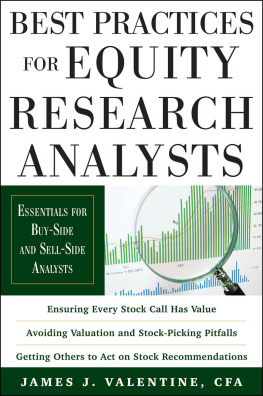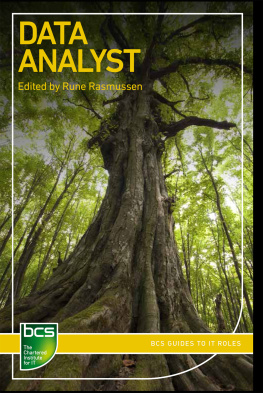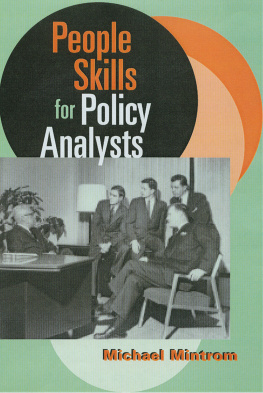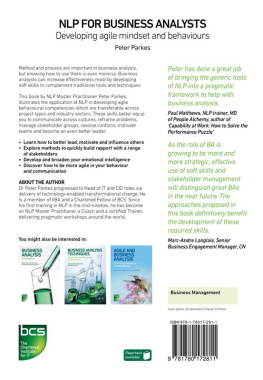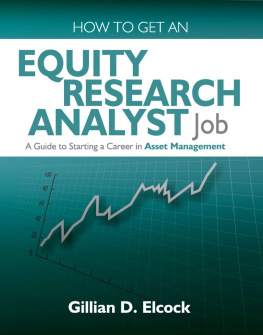James J. Valentine. - Best practices for equity research analysts: essentials for buy-side and sell-side analysts /
Here you can read online James J. Valentine. - Best practices for equity research analysts: essentials for buy-side and sell-side analysts / full text of the book (entire story) in english for free. Download pdf and epub, get meaning, cover and reviews about this ebook. City: New York :, year: c2011., publisher: McGraw-Hill,, genre: Politics. Description of the work, (preface) as well as reviews are available. Best literature library LitArk.com created for fans of good reading and offers a wide selection of genres:
Romance novel
Science fiction
Adventure
Detective
Science
History
Home and family
Prose
Art
Politics
Computer
Non-fiction
Religion
Business
Children
Humor
Choose a favorite category and find really read worthwhile books. Enjoy immersion in the world of imagination, feel the emotions of the characters or learn something new for yourself, make an fascinating discovery.
- Book:Best practices for equity research analysts: essentials for buy-side and sell-side analysts /
- Author:
- Publisher:McGraw-Hill,
- Genre:
- Year:c2011.
- City:New York :
- Rating:3 / 5
- Favourites:Add to favourites
- Your mark:
- 60
- 1
- 2
- 3
- 4
- 5
Best practices for equity research analysts: essentials for buy-side and sell-side analysts /: summary, description and annotation
We offer to read an annotation, description, summary or preface (depends on what the author of the book "Best practices for equity research analysts: essentials for buy-side and sell-side analysts /" wrote himself). If you haven't found the necessary information about the book — write in the comments, we will try to find it.
James J. Valentine.: author's other books
Who wrote Best practices for equity research analysts: essentials for buy-side and sell-side analysts /? Find out the surname, the name of the author of the book and a list of all author's works by series.
Best practices for equity research analysts: essentials for buy-side and sell-side analysts / — read online for free the complete book (whole text) full work
Below is the text of the book, divided by pages. System saving the place of the last page read, allows you to conveniently read the book "Best practices for equity research analysts: essentials for buy-side and sell-side analysts /" online for free, without having to search again every time where you left off. Put a bookmark, and you can go to the page where you finished reading at any time.
Font size:
Interval:
Bookmark:


Copyright 2011 by James J. Valentine. All rights reserved. Except as permitted under the United States Copyright Act of 1976, no part of this publication may be reproduced or distributed in any form or by any means, or stored in a database or retrieval system, without the prior written permission of the publisher.
ISBN: 978-007-173639-8
MHID: 007-173639-5
The material in this eBook also appears in the print version of this title: ISBN: 978-007-173638-1, MHID: 007-173638-7.
All trademarks are trademarks of their respective owners. Rather than put a trademark symbol after every occurrence of a trademarked name, we use names in an editorial fashion only, and to the benefit of the trademark owner, with no intention of infringement of the trademark. Where such designations appear in this book, they have been printed with initial caps.
McGraw-Hill eBooks are available at special quantity discounts to use as premiums and sales promotions, or for use in corporate training programs. To contact a representative please e-mail us at bulksales@mcgraw-hill.com.
This publication is designed to provide accurate and authoritative information in regard to the subject matter covered. It is sold with the understanding that neither the author nor the publisher is engaged in rendering legal, accounting, securities trading, or other professional services. If legal advice or other expert assistance is required, the services of a competent professional person should be sought.
From a Declaration of Principles jointly adopted by a Committee of the American Bar Association and a Committee of Publishers and Associations
TERMS OF USE
This is a copyrighted work and The McGraw-Hill Companies, Inc. (McGraw-Hill) and its licensors reserve all rights in and to the work. Use of this work is subject to these terms. Except as permitted under the Copyright Act of 1976 and the right to store and retrieve one copy of the work, you may not decompile, disassemble, reverse engineer, reproduce, modify, create derivative works based upon, transmit, distribute, disseminate, sell, publish or sublicense the work or any part of it without McGraw-Hills prior consent. You may use the work for your own noncommercial and personal use; any other use of the work is strictly prohibited. Your right to use the work may be terminated if you fail to comply with these terms.
THE WORK IS PROVIDED AS IS. McGRAW-HILL AND ITS LICENSORS MAKE NO GUARANTEES OR WARRANTIES AS TO THE ACCURACY, ADEQUACY OR COMPLETENESS OF OR RESULTS TO BE OBTAINED FROM USING THE WORK, INCLUDING ANY INFORMATION THAT CAN BE ACCESSED THROUGH THE WORK VIA HYPERLINK OR OTHERWISE, AND EXPRESSLY DISCLAIM ANY WARRANTY, EXPRESS OR IMPLIED, INCLUDING BUT NOT LIMITED TO IMPLIED WARRANTIES OF MERCHANTABILITY OR FITNESS FOR A PARTICULAR PURPOSE. McGraw-Hill and its licensors do not warrant or guarantee that the functions contained in the work will meet your requirements or that its operation will be uninterrupted or error free. Neither McGraw-Hill nor its licensors shall be liable to you or anyone else for any inaccuracy, error or omission, regardless of cause, in the work or for any damages resulting therefrom. McGraw-Hill has no responsibility for the content of any information accessed through the work. Under no circumstances shall McGraw-Hill and/or its licensors be liable for any indirect, incidental, special, punitive, consequential or similar damages that result from the use of or inability to use the work, even if any of them has been advised of the possibility of such damages. This limitation of liability shall apply to any claim or cause whatsoever whether such claim or cause arises in contract, tort or otherwise.
To Emma, Laura, Alice, and Robert for their loving support.
If we knew what it was we were doing, it would not be called research, would it?
Albert Einstein
I thoroughly enjoyed my career on Wall Street. I couldnt have asked for more thoughtful clients, talented team members, or supportive research management. But during those 16 years, I became intrigued by the criticism surrounding the quality of equity research, often coming from within the industry. There was no shortage of intelligent, hard-working individuals. So why wasnt there an abundance of world-class research? Im not sure that I solved the entire mystery, but I did reach one major conclusion: There are few, if any, quality control processes. Furthermore, there is minimal professional training provided to equity research analysts.
Think about it: An experienced portfolio manager is relying on internal buy-side and external sell-side analysts to provide accurate, insightful information to make decisions that can impact millions, and possibly billions, of dollars of return over the life of an investment. And yet most of these analysts never received professional training beyond what they picked up on the job and classes they may have taken in college. Instead, our profession relies on the medieval masterapprentice approach, which results in training only as good as the master. Our society doesnt allow this in the medical, legal, or accounting professions, or even for licensed plumbers or electricians. Those fields require that certain best practices be learned, and that mastery be validated by a certification process. The closest thing we have is the CFA certification, which is highly credible, but not required for the profession. (Only a fraction of equity analysts are CFAs.)
So how bad is it? Let me first say, Ive met more talented buy-side and sell-side analysts than I can countindividuals who produce impressive alpha-generating research. But unfortunately, this has been the exception more than the rule. As an analyst who worked at four of the largest sell-side firms in the United States, I witnessed too many inexperienced analysts making poorly constructed stock calls, often based on unsubstantiated theses (including me, during the first few years of my career). Worse yet, often in instances where the sell-side analysts produced good research, they couldnt effectively manage their franchise to get recognized by clients.
I didnt sense it was substantially better on the buy-side. Based on the 100 to 150 conversations I had with my clients every month, it was clear that there were too many buy-siders struggling in their roles, specifically failing to identify the factors most likely to drive their stocks. Occasionally, when I would get off the phone with a buy-side professional discussing a stock his or her fund owned, Id wonder how the person could fail to understand some of the more basic elements of the story. To illustrate my point, here are some real-world comments I heard during my career:
- I dont want to touch that stock because Im concerned about a labor strike (even though the company was non-union and would benefit from a strike at its unionized competitor).
- We sold the [transportation] stock because oil prices are likely to rise (even though this companys adjustable fuel surcharge was so lucrative that margins expanded when fuel prices rose).
- Im recommending this stock because were bullish on ethanol (even though ethanol was less than 1 percent of the companys revenue, and under an ultra-bullish scenario would go to no more than 3 percent of revenue over five years).
If these individuals were investing their own money, I could easily accept their misunderstanding of the companys fundamentals. But it was
Next pageFont size:
Interval:
Bookmark:
Similar books «Best practices for equity research analysts: essentials for buy-side and sell-side analysts /»
Look at similar books to Best practices for equity research analysts: essentials for buy-side and sell-side analysts /. We have selected literature similar in name and meaning in the hope of providing readers with more options to find new, interesting, not yet read works.
Discussion, reviews of the book Best practices for equity research analysts: essentials for buy-side and sell-side analysts / and just readers' own opinions. Leave your comments, write what you think about the work, its meaning or the main characters. Specify what exactly you liked and what you didn't like, and why you think so.

